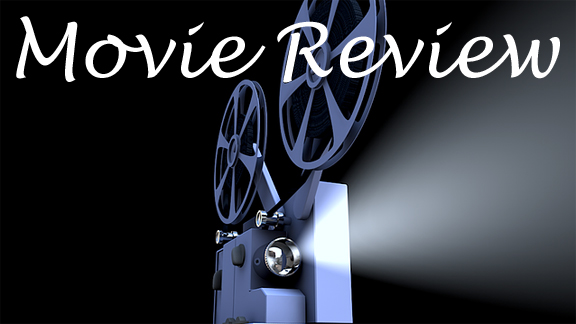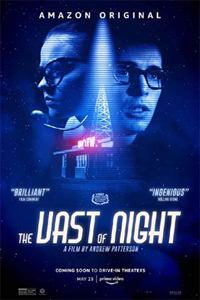Usually when a director drops his calling card, he has a few minor credits on his IMDB resume before that. But Andrew Patterson’s resume is empty other than “The Vast of Night” (Amazon Prime); the same goes for writers James Montague and Craig W. Sanger. The film itself shows few signs of being helmed by first-timers, and not only in the sense of professionalism, but more importantly in its original sense of style.
A sweeping lens
“The Vast of Night” brings us to Cayuga, New Mexico, in the late 1950s on the night of a high school basketball game. Cinematographer M.I. Littin-Menz sweeps his lens through the warm-ups – with players and cheerleaders in vintage attire, and a crowd filing in – as we meet our two leads: young radio DJ Everett (Jake Horowitz) and student Fay (Sierra McCormick), on her way to her shift operating the town’s telephone switchboard.
In what gives the illusion of an unbroken shot, Everett and Fay march around the parking lot trying out Fay’s new tape recorder, and then they walk across town to Fay’s switching station. The girl breathlessly tells the boy about what she has read in the latest science magazines. Everett says some of it sounds plausible – but not the concept of cellphones.

“The Vast of Night” (2020)
Director: Andrew Patterson
Writers: Andrew Patterson, Craig W. Sanger (screenplay)
Stars: Sierra McCormick, Jake Horowitz, Gail Cronauer
“The Vast of Night” is a heart-aching time capsule. Fay is amazed by hearing her own voice played back to her. She walks or runs everywhere, even when Everett has a car nearby; she forgets that a car is an option. The whole town is at the game except for a few oddballs and people who have jobs like Fay’s and Everett’s.
There’s no live broadcast of the game, because there’s no equipment for that, but Everett notes that it’ll be a popular replay tomorrow: Yes, people will know the outcome, but they love hearing their kids’ name on the radio.
Patterson makes the unusual decision to follow Everett and Fay from a dark, hazy distance. We don’t get a good look at these fresh-faced youths until they are at their work stations, and then the actors truly pull off long, unbroken shots. Fay deals with calls about a strange noise over the airwaves. Everett takes calls about the noise, including one from Billy (the voice of Bruce Davis), who recalls it from his Army days. The pleasure is in the details, as we see how the switchboard and the radio board operate.
Almost in real time
“The Vast of Night” unfolds roughly in real time, yet it’s intense rather than a slow burn over its 91 minutes. I would’ve liked it to slow down more; it’s sometimes jittery as Fay and Everett constantly react, hardly ever getting a chance to stop and think. There are some lightning-fast cute moments between them – like when Fay’s face falls in response to Everett’s dream to leave town for a better radio gig — but we don’t get to absorb this relationship.
Later, old shut-in Mabel (Gail Cronauer) gives a spree of exposition as she chronicles the loss of her child to an alien abduction; the tale and actress are good enough to allow the breaking of the “show, don’t tell” rule. Not just info-dumps, Billy’s and Mabel’s stories illustrate the times.
Their stories haven’t been believed because he is black and she is a woman who had a child out of wedlock. Indeed, Billy says the construction crew for housing a flying saucer (the Roswell UFO of 1947?) was all blacks and Mexicans. The government knows those people won’t be believed.
A mix of big and small filmmaking
“The Vast of Night” is an odd mix of high- and low-budget traits. The leads are young but experienced professionals, everything about the design takes us to the period, and the few special effects shots are solid. Perhaps money was saved with the hazy look, although it also happens to be a good choice, as I can imagine all of this being captured on an unearthed reel-to-reel tape.
The decision to frame the movie as an episode of “Paradox Theater” – complete with a “Twilight Zone”-esque introduction – is off point. The topic fits with old SF TV, but nothing about the style does.
And the topic won’t be gripping to most 2020 viewers. That said, Patterson gets close to refreshing this old trope. This was a decade before the moon landing, and the idea of aliens in the sky was plausible.
Patterson sells the flying saucer notion to 1950s viewers rather than 2020 viewers, counting on us having been pulled back 60 years by the filmmaking. He comes close to achieving it, but the story remains the weakest part of this otherwise remarkable calling card.


